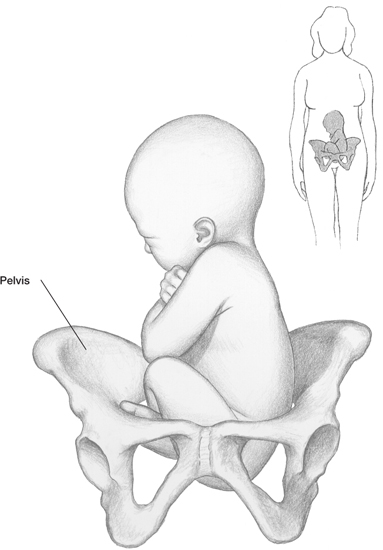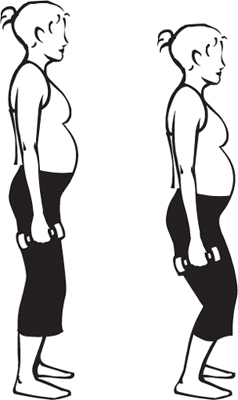6. Your Nutrition
You may not feel much like eating now,
but it’s important to eat healthfully. Snacks might be the answer—eat
small snacks throughout the day to keep your energy levels up and to
help avoid heartburn. You may also be tired of the foods you’ve been
eating. The list below offers some smart snacks for your healthy
nutrition:
• bananas, raisins, dried fruit and mangoes to satisfy your sweet tooth and to provide you with iron, potassium and magnesium
• string cheese; it’s high in calcium and protein
• fruit shakes made with skim milk and yogurt, ice milk or ice cream for calcium, vitamins and minerals

Baby aligned in the pelvis bottom first, with knees flexed,
is called a complete breech presentation.
• high-fiber crackers, spread with a little peanut butter for taste and protein
• cottage cheese and fruit, flavored with a little sugar and some cinnamon, for tasty milk and fruit servings
• salt-free chips or tortillas with salsa or bean dip for fiber and good taste
• hummus and pita slices for fiber and good taste
• fresh tomatoes, flavored with
some olive oil and fresh basil; eat with a few thin slices of Parmesan
cheese for a vegetable serving and dairy serving
• chicken or tuna salad (made from fresh chicken or tuna packed in water) and crackers or tortilla pieces for protein and fiber
7. You Should Also Know
What Is a Retained Placenta?
The placenta is usually delivered within
30 minutes after baby’s birth; it’s a routine part of delivery. In some
cases, a piece of placenta remains inside the uterus and doesn’t
deliver on its own. This is called a retained placenta. When it occurs, the uterus can’t contract enough, resulting in vaginal bleeding that can be heavy.
A retained placenta can occur for many
reasons. A placenta may attach over a previous Cesarean-section scar or
other scars on the uterus. Some experts are concerned the increasing
Cesarean-delivery rate may result in more placental problems. The
placenta may also attach over an area that was scraped or over an area
of the uterus that was infected at one time.
Grandma’s Remedy
If you want to avoid using medication,
try a folk remedy. If you have a stomachache, drink a 4-ounce glass of
warm water to which you’ve added 1 teaspoon of baking soda.
When the placenta doesn’t separate from the uterine wall, it can
be serious. However, it’s rare. Bleeding is usually severe after
delivery, and surgery may be necessary to stop it. An attempt may be
made to remove the placenta by D&C.
The medical term abnormal placentation
is used to describe placenta accreta, percreta and increta, in which
the placenta grows through the uterine wall, resulting in a retained
placenta. Serious bleeding can result.
Your healthcare provider will pay
attention to the delivery of your placenta while you’re paying
attention to your baby. Some people ask to see the placenta after
delivery; you may wish to have your healthcare provider show it to you.
Dad Tip
Ask your partner if there are things
she’d like you to bring to the hospital for her, such as an iPod or
special CDs and a CD player. Have things ready. If you take a tour of
the hospital or birthing center, you might get other ideas. Discuss
your role in labor and delivery with her; learn what you can do to help
her. You may be able to help maintain privacy. When people visit during
labor or after baby’s birth, be sure they don’t get too loud or it
doesn’t get crowded. Let your partner rest and recover; be her knight
in shining armor.
Will You Need to Be Shaved?
Many women want to know if they
have to have their pubic hair shaved before birth. It’s not a
requirement; many women are not shaved today. However, some women who
chose not to have their pubic hair shaved later said it hurt a lot when
their pubic hair became tangled in their underwear due to the normal
vaginal discharge after birth. You might want to think about this and
discuss it with your healthcare provider.
8. Exercise for Week 38
Stand with your feet shoulder-width
apart and your knees soft, with your arms by your side. Hold your tummy
in. Using light weights (2 to 3 pounds each to start; if you don’t have
weights, use a 16-ounce can), keep your hands by your hips, your head
up and back straight. Inhale as you squat about 6 inches; hold for 5
seconds. Exhale as you squeeze your buttocks muscles and return to the
standing position. Repeat 8 times. Strengthens quadriceps.
